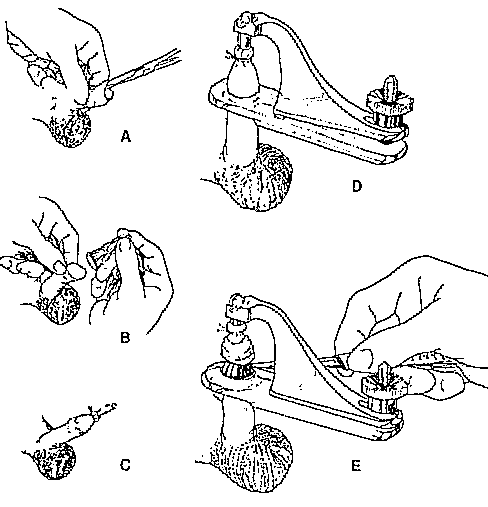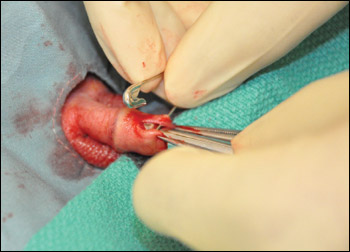Gomco
Construction Site
This article is work in progress and not yet part of the free encyclopedia IntactiWiki.
A Gomco clamp, otherwise known as a Yellen clamp,[1][2] is a specialized clamp for performing circumcisions. It was invented by Hiram S. Yellen and Aaron Goldstein in 1934-1935.[3][4] Gomco stands for the Goldstein Medical Company, the original manufacturer of the clamp.[2] In a 1998 study, it was the preferred circumcision technique of 67% of US physicians.[5]
Contents
Method
The technique is as follows:[6]
- Anesthetic should be applied (though it is a historically recent addition, dating only to approximately the early 1990s).
- The foreskin is gripped with two hemostats (tissue holders) and a tool is inserted between his foreskin and glans.[7]
- Once separated, a hemostat is used to pull his foreskin lengthwise in order to reduce bleeding.[7]
- Next, the foreskin is cut lengthwise through the stretched tissue (dorsal slit) to allow space to insert the circumcision device.[7]
- The bell of the Gomco clamp is placed over the glans, and the foreskin is pulled over the bell.
- The base of the Gomco clamp is placed over the bell, and the Gomco clamp's arm is fitted.
- After the surgeon confirms correct fitting and placement (and the amount of foreskin to be excised), the nut on the Gomco clamp is tightened, causing the clamping of nerves and blood flow to the foreskin.
- The Gomco clamp is left in place for about five minutes to allow clotting to occur, then the foreskin is severed using a scalpel.
- The Gomco's base and bell are then removed.
Description
From a 1935 article by Dr. Hiram Yellen, one of the two inventors (with Aaron Goldstein) of the Gomco Clamp.
...the dorsal aspect of the prepuce (A) is put on a stretch by grasping it on either side of the median line with a pair of haemostats. A flat probe, anointed with Vaseline, is then inserted between the prepuce and the glans to separate adherent mucous membrane. The prepuce is then gently drawn backward, exposing the entire glans penis. This is again cleaned. In case where the prepuce is drawn tightly over the glans, a partial dorsal slit will facilitate applying the cone of draw stud over the glans [?? sic]. (Note: If too long a slit is made, the cone has a tendency to slip of the glans. The slit should, therefore, be made only sufficiently long to enable the cone to be easily applied.)
After anointing the inside of the cone (B) , it is placed over the glans, allowing enough of the mucous membrane to fit below the cone so that too much is not removed. The prepuce is then pulled through and above the bevel hole in the platform (F), and clamped in place. In this way the prepuce is crushed against the cone, causing haemostasis. We allow this pressure to remain five minutes, and in older children slightly longer. The excess of the prepuce is then cut with a sharp knife without any danger of cutting the glans, which is always protected by the cone portion of the instrument, leaving a very fine one-thirty-second of an inch ribbon-like membrane formed between the new union of the skin and mucous membrane. The pressure is then released. The circumcision is completed and the penis covered with Vaseline gauze.
No anaesthesia is used.
On children older than twelve months, we find it advisable to insert a few sutures.
The pin
A small safety pin may be used to bring the edges of the dorsal slit together over the flare of the bell before bringing the draw stud through the base plate. The safety pin should be inserted through both the foreskin and the mucosa so that care is taken not to omit the mucosal layer. In addition, the clinician must take special care to make sure that the sharp end of the safety pin does not cause inadvertent injury to the clinician or the infant.[9]
Advantages
- The circumcision scar is straight.
- The circumcision is relatively quick compared to the more recent Plastibell.
Disadvantages
- Involves several small parts, all of which must be sterile so as to ensure the safety of the patient and minimize the risk of infection.
- Special care needs to be taken to match the correct size bell and clamp to prevent injuries to the glans.
- Procedure takes longer than the traditional Jewish Shield or Mogen Clamp techniques.
- The scar is more visible.
- The procedure may be more painful.
External links
Photos of a circumcision, by Dan Heller
References
- ↑ As a substitute for the Wikipedia [Template:cite journal], please use Template:REFjournal on the IntactiWiki.
- ↑ a b As a substitute for the Wikipedia [Template:cite journal], please use Template:REFjournal on the IntactiWiki.
- ↑ Template:Cite book
- ↑ As a substitute for the Wikipedia [Template:cite journal], please use Template:REFjournal on the IntactiWiki.
- ↑ As a substitute for the Wikipedia [Template:cite journal], please use Template:REFjournal on the IntactiWiki.
- ↑ As a substitute for the Wikipedia [Template:cite journal], please use Template:REFjournal on the IntactiWiki.
- ↑ a b c HealthWise Medical Reference, Available online at: http://children.webmd.com/tc/circumcision-what-happens-during-a-circumcision Last Updated: February 19, 2008.
- ↑ As a substitute for the Wikipedia [Template:cite journal], please use Template:REFjournal on the IntactiWiki.
- ↑ Template:Cite web



